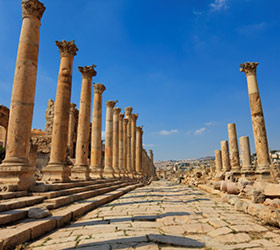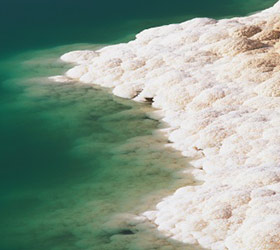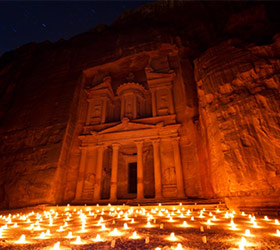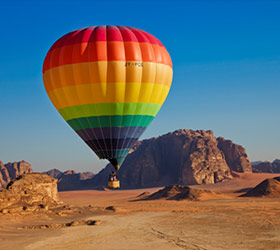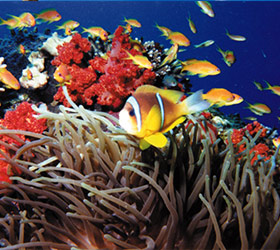Jordan
All Destinations
Jordan
Jordan is a land steeped in history. It has been home to some of mankind’s earliest settlements and villages, and relics of many of the worlds great civilizations can still be seen today.
Images of the ancient Nabataean city of Petra, carved from the rock over a thousand years ago, have long been most people’s first impression of Jordan. But while Petra is indeed one of the most stunning attractions in the Middle East, Jordan offers so much more for the modern traveller.
From the haunting, primeval starkness of Wadi Rum, to the teeming centre of urban Amman, from the majestic ruins of bygone civilizations to the timeless splendour of the Dead Sea, Jordan is unveiled as a unique destination offering breath-taking and mysterious sights, exquisite cuisine and countless activities that can provide visitors with inspiration, motivation, and rejuvenation.
For the active, horse riding, 4×4 safaris, rock climbing, diving and hiking are all on offer in abundance. For those who prefer a more leisurely break, nothing on earth compares to the Dead Sea where one can float with ease due to the high concentration of salt in the water, and the Red Sea famous for its colourful underwater world, both destinations boasting many spa facilities.
Marveling at herds of gazelles and oryx and migrating birds, camping amidst the grandeur of Wadi Rum or Dana Reserve, trekking the ancient caravan trails from the highlands of Moab and Edom, hiking the wooded hills of biblical Gilead, or experiencing the unique, cleansing mud baths of the Dead Sea are just a few examples of the treasures awaiting visitors to this unique kingdom.
An exceptional destination for families with children learning about the ancient civilisations, this is the perfect destination for educational holidays and soft adventure.
Quick Facts
Capital
Amman
Population
6.5 million
Area
89,342 sq km (34,492 sq miles)
Major Languages
Arabic
Major religion
Islam
Monetary Unit
Dinar
Flight time from London
5 hours
Time Difference
GMT + 2
When to go
For a small country, Jordan has an extraordinary range of climates.
The best time to visit climate-wise is in spring (March to May) and autumn (September to November), when the daytime temperatures aren’t too extreme. April is probably the best month, when temperatures are warm and wildflowers are in bloom. March can be cold and rainy in the north but is balmy by the Gulf of Aqaba and the Dead Sea.
Average daytime maximum temperatures in Amman range from 12.6°C in January to 32.5°C in August.
Winter can be surprisingly cold. Snow in Amman is not unheard of (even Petra gets the occasional fall) and the deserts can be freezing, especially at night. Make sure you have plenty of warm clothes and a windproof and waterproof jacket. Aqaba is the one exception, with average daytime maximum temperatures of around 20°C in January, and is quite a hit with deep-frozen northern Europeans during winter.
In high summer (July and August) the weather in the humid Jordan Valley is extremely oppressive – it feels like you’re trapped in an airless oven – with suffocating daytime highs well in excess of 36°C. It’s also fiercely hot in the desert (including Wadi Rum), though this is a dry heat and thus easier to deal with. The tourist authorities usually plan festivals (such as the Jerash Festival) for the summer period. If you do visit in summer, come well prepared with a hat, sunscreen and protective clothing.
The month of Ramadan is a time when visitors should not eat, drink or smoke in public during the day so it’s a tricky time to visit. Eid al-Fitr, the great celebration at the end of Ramadan, is a fun time to visit but it’s best to bunker down for a few days because public transport is heavily booked and hotel rooms are sometimes hard to find, especially in Aqaba.
Note also that most of the excellent ecotourism projects operated in Jordan’s Dana, Wadi Mujib and Ajlun nature reserves only operate between April and October.
- J
- F
- M
- A
- M
- J
- J
- A
- S
- O
- N
- D
- High Season
- Mid Season
- Shoulder Season
Highlights








Amman and Jerash
Amman, the capital of Jordan, is a fascinating city of contrasts – a unique blend of old and new, ideally situated on a hilly area between the desert and the fertile Jordan Valley.
In the heart of the city, ultra-modern buildings, hotels, smart restaurants, art galleries and boutiques rub shoulders comfortably with traditional coffee shops and tiny artisans’ workshops. The residential suburbs consist of mainly tree-lined streets and avenues flanked by elegant, almost uniformly white houses in accordance with a municipal law, which states that all buildings must be faced with local stone.
The downtown area is much older and more traditional with smaller businesses producing and selling everything from fabulous jewellery to everyday household items.
The people of Amman are multi-cultural, multi-denominational, well-educated and extremely hospitable. They welcome visitors and take pride in showing them around their fascinating and vibrant city.
A close second to Petra on the list of favourite destinations in Jordan is the ancient city of Jerash, which boasts an unbroken chain of human occupation dating back more than 6,500 years.
Jerash lies on a plain surrounded by hilly wooded areas and fertile basins. Conquered by General Pompey in 63 BC, it came under Roman rule and was one of the ten great Roman cities of the Decapolis League.
The city’s golden age came under Roman rule, during which time it was known as Gerasa, and the site is now generally acknowledged to be one of the best-preserved Roman provincial towns in the world. Hidden for centuries in sand before being excavated and restored over the past 70 years, Jerash reveals a fine example of the grand, formal provincial Roman urbanism that is found throughout the Middle East, comprising paved and colonnaded streets, soaring hilltop temples, handsome theatres, spacious public squares and plazas, baths, fountains and city walls pierced by towers and gates.





Dead Sea
Without a doubt the world’s most amazing place, the Jordan Rift Valley is a dramatic, beautiful landscape, which at the Dead Sea, is over 400m (1,312 ft.) below sea level.
The lowest point on the face of the earth, this vast stretch of water receives a number of incoming rivers, including the River Jordan. Once the waters reach the Dead Sea they are land-locked and have nowhere to go, so they evaporate, leaving behind a dense, rich, cocktail of salts and minerals that supply industry, agriculture and medicine with some of its finest products.
The Dead Sea is flanked by mountains to the east and the rolling hills of Jerusalem to the west, giving it an almost other-worldly beauty. Although sparsely populated and serenely quiet now, the area is believed to have been home to five Biblical cities: Sodom, Gomorrah, Adman, Zebouin and Zoar (Bela).
One of the most spectacular natural and spiritual landscapes in the world, the Jordanian east coast of the Dead Sea has evolved into a major hub of both religious and health & wellness tourism in the region. A series of good roads, excellent hotels with spa and fitness facilities, as well as archaeological and spiritual discoveries make this region as enticing to today’s international visitors as it was to kings, emperors, traders, prophets and pilgrims in antiquity.
The leading attraction at the Dead Sea is the warm, soothing, super salty water itself – some ten times saltier than sea water, and rich in chloride salts of magnesium, sodium, potassium, bromine and several others. The unusually warm, incredibly buoyant and mineral-rich waters have attracted visitors since ancient times, including King Herod the Great and the beautiful Egyptian Queen, Cleopatra. All of whom have luxuriated in the Dead Sea’s rich, black, stimulating mud and floated effortlessly on their backs while soaking up the water’s healthy minerals along with the gently diffused rays of the Jordanian sun.







Petra
The giant red mountains and vast mausoleums of a departed race have nothing in common with modern civilization, and ask nothing of it except to be appreciated at their true value – as one of the greatest wonders ever wrought by Nature and Man.
Petra, the world wonder, is without a doubt Jordan’s most valuable treasure and greatest tourist attraction. It is a vast, unique city, carved into the sheer rock face by the Nabataeans, an industrious Arab people who settled here more than 2000 years ago, turning it into an important junction for the silk, spice and other trade routes that linked China, India and southern Arabia with Egypt, Syria, Greece and Rome.
Entrance to the city is through the Siq, a narrow gorge, over 1km in length, which is flanked on either side by soaring, 80m high cliffs. Just walking through the Siq is an experience in itself. The colours and formations of the rocks are dazzling. As you reach the end of the Siq you will catch your first glimpse of Al-Khazneh (Treasury).
This is an awe-inspiring experience. A massive façade, 30m wide and 43m high, carved out of the sheer, dusky pink rock-face and dwarfing everything around it. It was carved in the early 1st century as the tomb of an important Nabataean king and represents the engineering genius of these ancient people.
The Treasury is merely the first of the many wonders that make up Petra. You will need at least four or five days to really explore everything here. As you enter the Petra valley you will be overwhelmed by the natural beauty of this place and its outstanding architectural achievements.
There are hundreds of elaborate rock-cut tombs with intricate carvings – unlike the houses, which were destroyed mostly by earthquakes, the tombs were carved to last throughout the afterlife and 500 have survived, empty but bewitching as you file past their dark openings. Here also is a massive Nabataean-built Roman-style theatre, which could seat 3,000 people. There are obelisks, temples, sacrificial altars and colonnaded streets, and high above, overlooking the valley, is the impressive Ad-Deir Monastery – a flight of 800 rock cut steps takes you there.
A 13th century shrine, built by the Mameluk Sultan, Al Nasir Mohammad, to commemorate the death of Aaron, the brother of Moses, can be seen on top of Mount Aaron in the Sharah range.













Wadi Rum
This is a stupendous, timeless place, virtually untouched by humanity and its destructive forces. Here, it is the weather and winds that have carved the imposing, towering skyscrapers, so elegantly described by T.E. Lawrence as “vast, echoing and God-like…”
A maze of monolithic rockscapes rise up from the desert floor to heights of 1,750m creating a natural challenge for serious mountaineers. Hikers can enjoy the tranquillity of the boundless empty spaces and explore the canyons and water holes to discover 4000-year-old rock drawings and the many other spectacular treasures this vast wilderness holds in store.
Also known as ‘The Valley of the Moon’, this is the place where Prince Faisal Bin Hussein and T.E. Lawrence based their headquarters during the Arab Revolt against the Ottomans in World War I, their exploits intrinsically woven into the history of this amazing area.
There are several options for exploring Wadi Rum. Drive for two or three hours into the Wadi system to explore some of the best known sites. Alternatively travel by a camel with a guide. We can also arrange a stay under the stars in a Bedouin tent, where you can enjoy a traditional campfire meal accompanied by Arabic music.
The Bedouin people that inhabit the area still maintain their semi-nomadic lifestyle. They are hospitable and offer a friendly welcome to visitors, often inviting them to sit and enjoy a coffee or even a meal.


Aqaba
With its wealth of other attractions, Jordan’s splendid Red Sea resort is often overlooked by modern-day visitors however; this is actually a great base from which to explore various places of interest in southern Jordan.
Aqaba is a fun place. It is a microcosm of all the good things Jordan has to offer, including a fascinating history with some outstanding sites.
Aqaba’s greatest asset is the Red Sea itself. Here you can experience some of the best snorkelling and diving in the world. The temperate climate and gentle water currents have created a perfect environment for the growth of corals and a teeming plethora of marine life. Here you can swim with friendly sea turtles and dolphins as they dart amongst the schools of multi-coloured fish. Night dives reveal the nocturnal sea creatures, crabs, lobsters and shrimp, as they search for a midnight snack.
For those who prefer to keep their feet dry, all the deep sea wonders can be viewed through a glass-bottomed boat or by submarine, or you can just relax under the sun on the resort’s sandy beaches. Plus, of course, there are plenty of other water-sport activities available, as well as an extensive and interesting Marine Park.








Amman and Jerash
Amman, the capital of Jordan, is a fascinating city of contrasts – a unique blend of old and new, ideally situated on a hilly area between the desert and the fertile Jordan Valley.
In the heart of the city, ultra-modern buildings, hotels, smart restaurants, art galleries and boutiques rub shoulders comfortably with traditional coffee shops and tiny artisans’ workshops. The residential suburbs consist of mainly tree-lined streets and avenues flanked by elegant, almost uniformly white houses in accordance with a municipal law, which states that all buildings must be faced with local stone.
The downtown area is much older and more traditional with smaller businesses producing and selling everything from fabulous jewellery to everyday household items.
The people of Amman are multi-cultural, multi-denominational, well-educated and extremely hospitable. They welcome visitors and take pride in showing them around their fascinating and vibrant city.
A close second to Petra on the list of favourite destinations in Jordan is the ancient city of Jerash, which boasts an unbroken chain of human occupation dating back more than 6,500 years.
Jerash lies on a plain surrounded by hilly wooded areas and fertile basins. Conquered by General Pompey in 63 BC, it came under Roman rule and was one of the ten great Roman cities of the Decapolis League.
The city’s golden age came under Roman rule, during which time it was known as Gerasa, and the site is now generally acknowledged to be one of the best-preserved Roman provincial towns in the world. Hidden for centuries in sand before being excavated and restored over the past 70 years, Jerash reveals a fine example of the grand, formal provincial Roman urbanism that is found throughout the Middle East, comprising paved and colonnaded streets, soaring hilltop temples, handsome theatres, spacious public squares and plazas, baths, fountains and city walls pierced by towers and gates.





Dead Sea
Without a doubt the world’s most amazing place, the Jordan Rift Valley is a dramatic, beautiful landscape, which at the Dead Sea, is over 400m (1,312 ft.) below sea level.
The lowest point on the face of the earth, this vast stretch of water receives a number of incoming rivers, including the River Jordan. Once the waters reach the Dead Sea they are land-locked and have nowhere to go, so they evaporate, leaving behind a dense, rich, cocktail of salts and minerals that supply industry, agriculture and medicine with some of its finest products.
The Dead Sea is flanked by mountains to the east and the rolling hills of Jerusalem to the west, giving it an almost other-worldly beauty. Although sparsely populated and serenely quiet now, the area is believed to have been home to five Biblical cities: Sodom, Gomorrah, Adman, Zebouin and Zoar (Bela).
One of the most spectacular natural and spiritual landscapes in the world, the Jordanian east coast of the Dead Sea has evolved into a major hub of both religious and health & wellness tourism in the region. A series of good roads, excellent hotels with spa and fitness facilities, as well as archaeological and spiritual discoveries make this region as enticing to today’s international visitors as it was to kings, emperors, traders, prophets and pilgrims in antiquity.
The leading attraction at the Dead Sea is the warm, soothing, super salty water itself – some ten times saltier than sea water, and rich in chloride salts of magnesium, sodium, potassium, bromine and several others. The unusually warm, incredibly buoyant and mineral-rich waters have attracted visitors since ancient times, including King Herod the Great and the beautiful Egyptian Queen, Cleopatra. All of whom have luxuriated in the Dead Sea’s rich, black, stimulating mud and floated effortlessly on their backs while soaking up the water’s healthy minerals along with the gently diffused rays of the Jordanian sun.







Petra
The giant red mountains and vast mausoleums of a departed race have nothing in common with modern civilization, and ask nothing of it except to be appreciated at their true value – as one of the greatest wonders ever wrought by Nature and Man.
Petra, the world wonder, is without a doubt Jordan’s most valuable treasure and greatest tourist attraction. It is a vast, unique city, carved into the sheer rock face by the Nabataeans, an industrious Arab people who settled here more than 2000 years ago, turning it into an important junction for the silk, spice and other trade routes that linked China, India and southern Arabia with Egypt, Syria, Greece and Rome.
Entrance to the city is through the Siq, a narrow gorge, over 1km in length, which is flanked on either side by soaring, 80m high cliffs. Just walking through the Siq is an experience in itself. The colours and formations of the rocks are dazzling. As you reach the end of the Siq you will catch your first glimpse of Al-Khazneh (Treasury).
This is an awe-inspiring experience. A massive façade, 30m wide and 43m high, carved out of the sheer, dusky pink rock-face and dwarfing everything around it. It was carved in the early 1st century as the tomb of an important Nabataean king and represents the engineering genius of these ancient people.
The Treasury is merely the first of the many wonders that make up Petra. You will need at least four or five days to really explore everything here. As you enter the Petra valley you will be overwhelmed by the natural beauty of this place and its outstanding architectural achievements.
There are hundreds of elaborate rock-cut tombs with intricate carvings – unlike the houses, which were destroyed mostly by earthquakes, the tombs were carved to last throughout the afterlife and 500 have survived, empty but bewitching as you file past their dark openings. Here also is a massive Nabataean-built Roman-style theatre, which could seat 3,000 people. There are obelisks, temples, sacrificial altars and colonnaded streets, and high above, overlooking the valley, is the impressive Ad-Deir Monastery – a flight of 800 rock cut steps takes you there.
A 13th century shrine, built by the Mameluk Sultan, Al Nasir Mohammad, to commemorate the death of Aaron, the brother of Moses, can be seen on top of Mount Aaron in the Sharah range.













Wadi Rum
This is a stupendous, timeless place, virtually untouched by humanity and its destructive forces. Here, it is the weather and winds that have carved the imposing, towering skyscrapers, so elegantly described by T.E. Lawrence as “vast, echoing and God-like…”
A maze of monolithic rockscapes rise up from the desert floor to heights of 1,750m creating a natural challenge for serious mountaineers. Hikers can enjoy the tranquillity of the boundless empty spaces and explore the canyons and water holes to discover 4000-year-old rock drawings and the many other spectacular treasures this vast wilderness holds in store.
Also known as ‘The Valley of the Moon’, this is the place where Prince Faisal Bin Hussein and T.E. Lawrence based their headquarters during the Arab Revolt against the Ottomans in World War I, their exploits intrinsically woven into the history of this amazing area.
There are several options for exploring Wadi Rum. Drive for two or three hours into the Wadi system to explore some of the best known sites. Alternatively travel by a camel with a guide. We can also arrange a stay under the stars in a Bedouin tent, where you can enjoy a traditional campfire meal accompanied by Arabic music.
The Bedouin people that inhabit the area still maintain their semi-nomadic lifestyle. They are hospitable and offer a friendly welcome to visitors, often inviting them to sit and enjoy a coffee or even a meal.


Aqaba
With its wealth of other attractions, Jordan’s splendid Red Sea resort is often overlooked by modern-day visitors however; this is actually a great base from which to explore various places of interest in southern Jordan.
Aqaba is a fun place. It is a microcosm of all the good things Jordan has to offer, including a fascinating history with some outstanding sites.
Aqaba’s greatest asset is the Red Sea itself. Here you can experience some of the best snorkelling and diving in the world. The temperate climate and gentle water currents have created a perfect environment for the growth of corals and a teeming plethora of marine life. Here you can swim with friendly sea turtles and dolphins as they dart amongst the schools of multi-coloured fish. Night dives reveal the nocturnal sea creatures, crabs, lobsters and shrimp, as they search for a midnight snack.
For those who prefer to keep their feet dry, all the deep sea wonders can be viewed through a glass-bottomed boat or by submarine, or you can just relax under the sun on the resort’s sandy beaches. Plus, of course, there are plenty of other water-sport activities available, as well as an extensive and interesting Marine Park.
Where to stay
These are just a selection of the properties we can personally recommend. Please get in touch to hear more about our full portfolio.
Four Seasons, Amman
Located between the prestigious Al Sweifiyah residential area and the Shmeisani financial district, Four Seasons Amman is a crown jewel in the heart of Jordan’s bustling capital city. Set atop the highest of Amman’s seven hills, the Four Seasons hast set a new standard of quality and excellence.
Kempinski Aqaba
Gracefully situated on the white sandy beaches and azure waters of the Red Sea, The Kempinski Aqaba offers a transcendent sensory experience. With an array of culinary options, leisure activities and top-tier pampering that is perfectly at home within the picturesque surroundings, this is an ideal base for explorers and leisure seekers alike.
Kempinksi Ishtar
In a region unlike any other, hidden away for centuries in the cradle of time and located 400 metres below sea level, nature and history have so wonderfully conspired to create the backdrop of the Kempinski Ishtar. Set amidst gardens dotted with lagoons, waterfalls and private pools, it provides guests with absolute privacy in a serene and exclusive setting.
Get in touch with us now to start planning your journey
Follow Us
Proudly ASSOCIATED WITH








